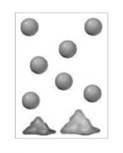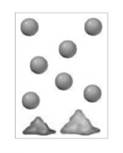
Chemistry, Books a la Carte Edition and Modified Mastering Chemistry with Pearson eText & ValuePack Access Card (7th Edition)
7th Edition
ISBN: 9780134172514
Author: John E. McMurry
Publisher: PEARSON
expand_more
expand_more
format_list_bulleted
Question
Chapter 14, Problem 14.30A
(a)
Interpretation Introduction
To draw:
Pictures of equilibrium mixture after addition of four more CO2 molecules to an equilibrium mixture of solid

(b)
Interpretation Introduction
To draw:
Picture of equilibrium mixture at a higher temperature

Expert Solution & Answer
Want to see the full answer?
Check out a sample textbook solution
Students have asked these similar questions
How to draw the mechanism for this reaction??
3) Draw a detailed mechanism and predict the product of the reaction shown?
1) EtMgBr
2) H3O+
How to draw the mechanism for this reaction?
Chapter 14 Solutions
Chemistry, Books a la Carte Edition and Modified Mastering Chemistry with Pearson eText & ValuePack Access Card (7th Edition)
Ch. 14 - Prob. 14.1PCh. 14 - APPLY 14.2 Nitrogen dioxide, a pollutant that...Ch. 14 - Prob. 14.3PCh. 14 - APPLY 14.4 Lactic acid, which builds up in muscle...Ch. 14 - Conceptual PRACTICE 14.5 The following pictures...Ch. 14 - Conceptual APPLY 14.6 The equilibrium constant...Ch. 14 - PRACTICE 14.7 In the industrial synthesis of...Ch. 14 - APPLY 14.8 At 25 °C, Kp = 25 for the reaction...Ch. 14 - Prob. 14.9PCh. 14 - APPLY 14.10For the reaction...
Ch. 14 - Prob. 14.11PCh. 14 - APPLY 14.12 Magnesium hydroxide is the active...Ch. 14 - Prob. 14.13PCh. 14 - Prob. 14.14ACh. 14 - Prob. 14.15PCh. 14 - Conceptual APPLY 14.16 The reaction A2 + B2 2...Ch. 14 - PRACTICE 14.17 The H2/CO ratio in mixtures of...Ch. 14 - APPLY 14.18 Calculate the equilibrium...Ch. 14 - PRACTICE 14.19 Calculate the equilibrium...Ch. 14 - APPLY 14.20 Calculate the equilibrium...Ch. 14 - Prob. 14.21PCh. 14 - Prob. 14.22ACh. 14 - Prob. 14.23PCh. 14 - Prob. 14.24ACh. 14 - Prob. 14.25PCh. 14 - Prob. 14.26ACh. 14 - Prob. 14.27PCh. 14 - Prob. 14.28ACh. 14 - Prob. 14.29PCh. 14 - Prob. 14.30ACh. 14 - Prob. 14.31PCh. 14 - Prob. 14.32ACh. 14 - Prob. 14.33PCh. 14 - Prob. 14.34PCh. 14 - Prob. 14.35PCh. 14 - Prob. 14.36PCh. 14 - PROBLEM 14.37 The affinity of hemoglobin (Hb) for...Ch. 14 - Prob. 14.38PCh. 14 - Prob. 14.39CPCh. 14 - The following pictures represent the equilibrium...Ch. 14 - The reaction A2+BA+AB has an equilibrium constant...Ch. 14 - Prob. 14.42CPCh. 14 - Prob. 14.43CPCh. 14 - Prob. 14.44CPCh. 14 - The following pictures represent equilibrium...Ch. 14 - Prob. 14.46CPCh. 14 - Prob. 14.47CPCh. 14 - Prob. 14.48CPCh. 14 - Prob. 14.49CPCh. 14 - Prob. 14.50SPCh. 14 - Identify the true statement about the...Ch. 14 - Prob. 14.52SPCh. 14 - Prob. 14.53SPCh. 14 - For each of the following equilibria, write the...Ch. 14 - Prob. 14.55SPCh. 14 - Prob. 14.56SPCh. 14 - Prob. 14.57SPCh. 14 - For each of the following equilibria, write the...Ch. 14 - Prob. 14.59SPCh. 14 - 14.60 If Kc = 7.5 × 10-9 at 1000 K for the...Ch. 14 - Prob. 14.61SPCh. 14 - Prob. 14.62SPCh. 14 - Prob. 14.63SPCh. 14 - Prob. 14.64SPCh. 14 - Prob. 14.65SPCh. 14 - Prob. 14.66SPCh. 14 - Prob. 14.67SPCh. 14 - Prob. 14.68SPCh. 14 - Prob. 14.69SPCh. 14 - Prob. 14.70SPCh. 14 - Prob. 14.71SPCh. 14 - Prob. 14.72SPCh. 14 - Prob. 14.73SPCh. 14 - Prob. 14.74SPCh. 14 - Prob. 14.75SPCh. 14 - Prob. 14.76SPCh. 14 - Prob. 14.77SPCh. 14 - Prob. 14.78SPCh. 14 - Prob. 14.79SPCh. 14 - Prob. 14.80SPCh. 14 - Prob. 14.81SPCh. 14 - Prob. 14.82SPCh. 14 - Prob. 14.83SPCh. 14 - Prob. 14.84SPCh. 14 - Prob. 14.85SPCh. 14 - Prob. 14.86SPCh. 14 - Prob. 14.87SPCh. 14 - Prob. 14.88SPCh. 14 - Prob. 14.89SPCh. 14 - Prob. 14.90SPCh. 14 - Prob. 14.91SPCh. 14 - Prob. 14.92SPCh. 14 - Prob. 14.93SPCh. 14 - Prob. 14.94SPCh. 14 - Prob. 14.95SPCh. 14 - Prob. 14.96SPCh. 14 - Prob. 14.97SPCh. 14 - Prob. 14.98SPCh. 14 - Prob. 14.99SPCh. 14 - Prob. 14.100SPCh. 14 - Prob. 14.101SPCh. 14 - Prob. 14.102SPCh. 14 - Prob. 14.103SPCh. 14 - Prob. 14.104SPCh. 14 - Consider the endothermic reaction...Ch. 14 - Prob. 14.106SPCh. 14 - Prob. 14.107SPCh. 14 - Prob. 14.108SPCh. 14 - Prob. 14.109SPCh. 14 - Prob. 14.110SPCh. 14 - Prob. 14.111SPCh. 14 - Prob. 14.112SPCh. 14 - Prob. 14.113SPCh. 14 - Prob. 14.114SPCh. 14 - Prob. 14.115SPCh. 14 - Prob. 14.116SPCh. 14 - Prob. 14.117SPCh. 14 - Prob. 14.118SPCh. 14 - Forward and reverse rate constants for the...Ch. 14 - Prob. 14.120CPCh. 14 - Prob. 14.121CPCh. 14 - Prob. 14.122CPCh. 14 - Prob. 14.123CPCh. 14 - Prob. 14.124CPCh. 14 - Prob. 14.125CPCh. 14 - Prob. 14.126CPCh. 14 - Prob. 14.127CPCh. 14 - Prob. 14.128CPCh. 14 - Prob. 14.129CPCh. 14 - Prob. 14.130CPCh. 14 - At 1000 K, Kp, = 2.1 106 and H=107.7kJ for the...Ch. 14 - Prob. 14.132CPCh. 14 - Prob. 14.133CPCh. 14 - Prob. 14.134CPCh. 14 - Prob. 14.135CPCh. 14 - Prob. 14.136CPCh. 14 - Prob. 14.137CPCh. 14 - Prob. 14.138CPCh. 14 - Prob. 14.139CPCh. 14 - Prob. 14.140CPCh. 14 - Prob. 14.141CPCh. 14 - Prob. 14.142CPCh. 14 - Prob. 14.143CPCh. 14 - Prob. 14.144CPCh. 14 - Prob. 14.145CPCh. 14 - Prob. 14.146CPCh. 14 - Prob. 14.147MPCh. 14 - Prob. 14.148MPCh. 14 - Prob. 14.149MPCh. 14 - Prob. 14.150MPCh. 14 - Prob. 14.151MPCh. 14 - Prob. 14.152MPCh. 14 - Prob. 14.153MPCh. 14 - Prob. 14.154MPCh. 14 - Prob. 14.155MPCh. 14 - Prob. 14.156MPCh. 14 - Prob. 14.157MPCh. 14 - Prob. 14.158MPCh. 14 - Prob. 14.159MP
Knowledge Booster
Learn more about
Need a deep-dive on the concept behind this application? Look no further. Learn more about this topic, chemistry and related others by exploring similar questions and additional content below.Similar questions
- > H₂C=C-CH2-CH3 B. H₂O Pt C. + H2 + H₂O H D. 16. Give the IUPAC name for each of the following: B. Cl Cl c. Cl Cl 17. Draw the line-angle formula for each of the following compounds: 1. phenol 2. 1,3-dichlorobenzene 3. 4-ethyltoluene < Previous Submit Assignment Next ▸arrow_forwardno Ai walkthroughsarrow_forwardThe answer is shown. What is the reaction mechanism to arrive at the answer?arrow_forward
- no Ai walkthroughsarrow_forwardConsider the following nucleophilic substitution reaction. The compound listed above the arrow is the solvent for the reaction. If nothing is listed over the arrow, then the nucleophile is also the solvent for the reaction. Part 1 of 2 Br CH,CN + I¯ What is the correct mechanism for the reaction? Select the single best answer. @SN2 ○ SN 1 Part: 1/2 Part 2 of 2 Draw the products for the reaction. Include both the major organic product and the inorganic product. If more than one stereoisomer is possible, draw only one stereoisomer. Include stereochemistry where relevant. Click and drag to start drawing a structure. X હૈarrow_forward20.33 Think-Pair-Share (a) Rank the following dienes and dienophiles in order of increasing reactivity in the Diels-Alder reaction. (i) CO₂Et (ii) COEt || CO₂Et MeO MeO (b) Draw the product that results from the most reactive diene and most reactive dienophile shown in part (a). (c) Draw a depiction of the orbital overlap involved in the pericyclic reaction that oc- curs between the diene and dienophile in part (b). (d) Is the major product formed in part (b) the endo or exo configuration? Explain your reasoning.arrow_forward
- 20.40 The following compound undergoes an intramolecular Diels-Alder reaction to give a tricyclic product. Propose a structural formula for the product. CN heat An intramolecular Diels-Alder adductarrow_forwardWhat is the reaction mechanism for this? Can this even be done without a base?arrow_forwardWhat is the reaction mechanism for this?arrow_forward
- What is the reaction mechanism for this?arrow_forwardWhat is the reaction mechanism for this?arrow_forwardCurved arrows are used to illustrate the flow of electrons. Using the provided starting and product structures, draw the curved electron-pushing arrows for the following reaction or mechanistic step(s). Be sure to account for all bond-breaking and bond-making steps. + Drawing Arrows CH3ONA, CH3OH heat : Br:O Na → H H Br Na + H H H H H :0: .H + Undo Reset Done Q CH3 Drag To Pan +arrow_forward
arrow_back_ios
SEE MORE QUESTIONS
arrow_forward_ios
Recommended textbooks for you
 ChemistryChemistryISBN:9781305957404Author:Steven S. Zumdahl, Susan A. Zumdahl, Donald J. DeCostePublisher:Cengage Learning
ChemistryChemistryISBN:9781305957404Author:Steven S. Zumdahl, Susan A. Zumdahl, Donald J. DeCostePublisher:Cengage Learning ChemistryChemistryISBN:9781259911156Author:Raymond Chang Dr., Jason Overby ProfessorPublisher:McGraw-Hill Education
ChemistryChemistryISBN:9781259911156Author:Raymond Chang Dr., Jason Overby ProfessorPublisher:McGraw-Hill Education Principles of Instrumental AnalysisChemistryISBN:9781305577213Author:Douglas A. Skoog, F. James Holler, Stanley R. CrouchPublisher:Cengage Learning
Principles of Instrumental AnalysisChemistryISBN:9781305577213Author:Douglas A. Skoog, F. James Holler, Stanley R. CrouchPublisher:Cengage Learning Organic ChemistryChemistryISBN:9780078021558Author:Janice Gorzynski Smith Dr.Publisher:McGraw-Hill Education
Organic ChemistryChemistryISBN:9780078021558Author:Janice Gorzynski Smith Dr.Publisher:McGraw-Hill Education Chemistry: Principles and ReactionsChemistryISBN:9781305079373Author:William L. Masterton, Cecile N. HurleyPublisher:Cengage Learning
Chemistry: Principles and ReactionsChemistryISBN:9781305079373Author:William L. Masterton, Cecile N. HurleyPublisher:Cengage Learning Elementary Principles of Chemical Processes, Bind...ChemistryISBN:9781118431221Author:Richard M. Felder, Ronald W. Rousseau, Lisa G. BullardPublisher:WILEY
Elementary Principles of Chemical Processes, Bind...ChemistryISBN:9781118431221Author:Richard M. Felder, Ronald W. Rousseau, Lisa G. BullardPublisher:WILEY

Chemistry
Chemistry
ISBN:9781305957404
Author:Steven S. Zumdahl, Susan A. Zumdahl, Donald J. DeCoste
Publisher:Cengage Learning

Chemistry
Chemistry
ISBN:9781259911156
Author:Raymond Chang Dr., Jason Overby Professor
Publisher:McGraw-Hill Education

Principles of Instrumental Analysis
Chemistry
ISBN:9781305577213
Author:Douglas A. Skoog, F. James Holler, Stanley R. Crouch
Publisher:Cengage Learning

Organic Chemistry
Chemistry
ISBN:9780078021558
Author:Janice Gorzynski Smith Dr.
Publisher:McGraw-Hill Education

Chemistry: Principles and Reactions
Chemistry
ISBN:9781305079373
Author:William L. Masterton, Cecile N. Hurley
Publisher:Cengage Learning

Elementary Principles of Chemical Processes, Bind...
Chemistry
ISBN:9781118431221
Author:Richard M. Felder, Ronald W. Rousseau, Lisa G. Bullard
Publisher:WILEY
Chemical Equilibria and Reaction Quotients; Author: Professor Dave Explains;https://www.youtube.com/watch?v=1GiZzCzmO5Q;License: Standard YouTube License, CC-BY